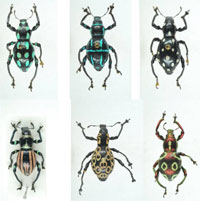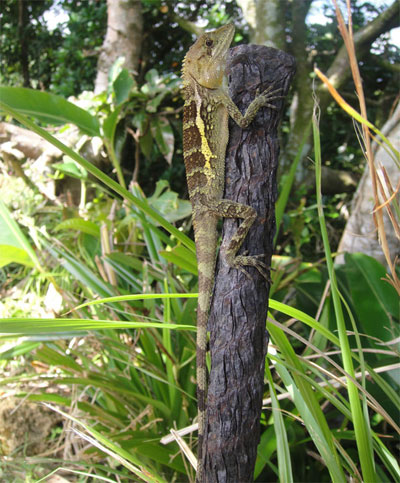We have moved to a new server!
Since March 2014, this website has been moved to this new server: http://web.ntnu.edu.tw/~treehopper/. This page will not be updated anymore. Please update your browser’s bookmark or the web links.
Member list
Current members
- Jo-Fan Wang
- 1. The Territorial Behavior of Euphaea formosa (Odonata). 2. Tempo and Mode of Pronotal Evolution in Membracis Treehoppers.
- Hung-Nien Chen
- 1. The effect of typhoon on survivalship of Matrona cyanoptera. 2. Modes of phenotypic variation in Euphaea amphicyana.
- Lan-Wai Yeh
- Ecology and evolution of Taiwanese Carabus ground beetles.
- Yun-Chieh Cheng
- What do damselfly larvae eat? DNA barcode analyses of larval diet in Matrona cyanoptera and Euphaea formosa.
- Chung-Hsin Huang
- Flucuating Asymmetry and Developmental Asymmetry of Cyclommatus mniszechi.
- Hui-Yun Tseng
- I-Ting Hsiao
- Variation of genitalia in Euphaea amphicyana.
- Yen-Ting Chen
- The effect of forest management of Mt. Da-Shiue on the morphological variation of a ground beetle, Carabus (Apotomopterus) masuzoi.
- Jyun-Huei Huang
- The fighting behavior of a stag beetle, Rhaetulus crenatus.
- Shi-Ting Wu
- Membracis Phyllotropis.
- Chiao-Wei Lin
- The fighting behavior of a stag beetle, Rhaetulus crenatus.
- Yong-Chao Su
- Behavioral ecology, sociobiology, population genetics, and molecular phylogenetics.
Past members
- Wei-Liang Xiao
- Variation of wing veins in Euphaea amphicyana.
- Li-Wen Weng
- Why do firefly larvae emit light?
- Yat-Hung Lee
- Speciation of Euphaea damselflies.
- Che-Yu Kuan
- Variation of mandibles in stag beetles.
- Chu-Yen Cheng
- Phylogeography of a Philippine's treehopper, Leptocentrus reponens.
- Ming-Yu Chen
- Phylogeography and population history of the treehoppers, Centrochares horifficus from the Philippines Archipelago.
- Shao-Chang Huang
- Visual Communication of Matrona cyanoptera
- Jen-Pan Huang
- Population Genetics and Phylogeographic Analyses of Formosan Damselfly, Euphaea Formosa (Insecta: Odonata: Euphaeidae) from Taiwan
- Wei-Yun Chen
- Molecular and Phylogenetic Characterization of Endosymbiotic Bacteria of the Froghopper, Okiscarta uchidae (Insecta: Hemiptera: Cercopidae)
Visiting scholars and students
- Vanitha Williams
- Predatory potential of waterbug, Diplonychus rusticus and dragonfly, Diplacodes trivialis on mosquito larvae.
- Marina Vilenica
- Dragonfly composition (Insecta, Odonata) in wetland area of Turopolje region, Croatia
- Klaas-Douwe 'KD' B. Dijkstra
- History, diversity and identification of dragonflies and damselflies (Odonata).
- Erin McCullough
- " Diversification of weapon form: aerodynamic costs of beetle horns.
- Ashley E. King
- Intrasexual combat and intersexual antagonistic co-evolution in horned beetles.
Hui-Yun Tseng

Title
PhD Student 2011
Species: Pachyrrhynchus spp.

Project
1. Biological function of coloration in Pachyrrhynchus tobafolius. 2. Phylogeny and color evolution of Pachyrrhynchus weevils. 3. Population genetics of Pachyrrhynchus weevils on Lanyu and Green Island.
Abstrct
E-mail:hytseng1216@gmail.com
The flightless pachyrrhynchid weevils are members of the largest beetle family Curculionidae. Most pachyrrhynchid weevils are decorated with colorful and iridescent markings on their bodies, which are extremely rigid with fused elytra. Distributed mainly from the tropical Philippine archipelago north to the Ryukyu islands, these insects represent an astonishingly high level of morphological and species diversity on these oceanic islands. In this study, we focus on three questions in pachyrrhynchids: 1. Biological function of colorful markings: the brilliant coloration of pachyrrhynchids may function as crypsis, aposematic or mating signals, and we will test these hypotheses using behavioral experiments in the laboratory and field. 2. Phylogeny and color evolution of Pachyrrhynchus weevils: using mitochondrial and nuclear genes, we can infer the phylogenetic relationships between taxa differing in color, and reconstruct the evolutionary history of coloration. 3. Degree and direction of gene flow between weevil populations on Lanyu and Green Island: genetic divergence and homogeneity depend on the strength of gene flow among different populations. Many factors may affect the population dispersal and therefore mediate the direction of gene flow. We will analyze the degree and direction of gene flow between pachyrrhynchid populations in Lanyu and Green Island, and test whether the direction is consistent with the flow of Kuroshio currents.
Topic 1
Colours of Pachyrrhynchus weevils function as aposematic visual cues for Swinhoe’s tree lizard (Japalura swinhonis)

Abstract
Aposematic coloration or warning signals of preys can be used to advertise their un-palatability, therefore deter potential predators. Pachyrrhynchus weevils are a group of insects often decorated with colorful and iridescent markings. Because of their extremely rigid elytra and a remarkable similarity between these weevils and other insects (e.g. longhorn beetles and crickets), these colors were considered as aposematic signals. However, there was no scientific evidence supporting this hypothesis. In this study, we used Swinhoe’s tree lizard (Japalura swinhonis) as a predator and two weevil species, P. tobafolius and Kashotonus multipuctatus as prey to examine two hypotheses: 1) the conspicuous coloration function as aposematic signals, and 2) the lizards sympatric with the weevils avoid these prey, whereas allopatric and naïve lizards attack these presumably unpalatable prey. In the first experiment, both P. tobafolius and K. multipuctatus with intact or artificially removed colors were used to test whether sympatric lizards have different predation attempts. The results showed that sympatric lizards attack more frequently on both weevil species without markings than that with markings. In the second experiment, we used sympatric and allopatric lizards to test whether these lizards recognize these weevils as unpalatable prey. The results showed an existence of geographical variation in predation response among lizard populations, where allopatric lizards made significantly more predatory attempts on the weevils than that of sympatric lizards. These findings suggest that the coloration of Pachyrrhynchus weevil functions as an aposematic signal for sympatric Swinhoe’s tree lizard populations.